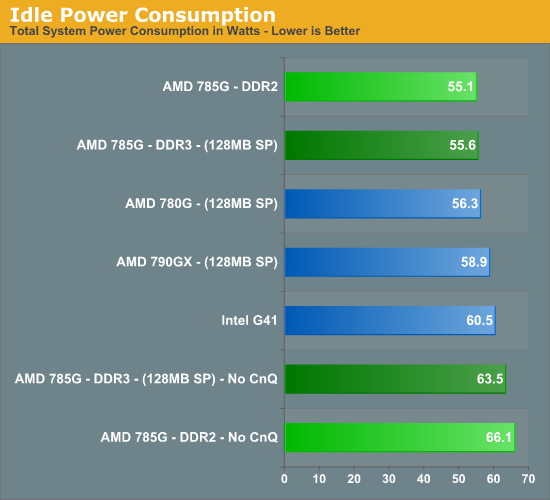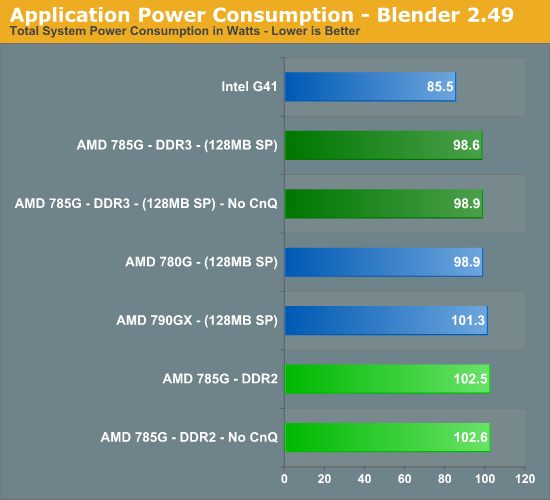AMD's 785G Chipset - Revolutionary or Evolutionary?
by Gary Key on August 4, 2009 5:00 AM EST- Posted in
- Motherboards
Power Consumption testing on the AMD platforms is always a hit or miss event. Either all the stars are aligned, more like the BIOS and driver sets are matched perfectly, or we enter the black hole known simply as Cool-n-Quiet. We had more problems getting CnQ to work properly on our early review samples than California does getting a balanced budget in place. Honestly, we have to wonder just how hard it can be to get the BIOS code in this area to stay consistent.
The reason we mention this is that just about every board had a problem with it. The first BIOS works but something else needs tuning, the second BIOS breaks CnQ, then the third fixes it, and the fourth revision breaks it again. On and on it went until Friday when not only did solid BIOS releases appear but also drivers that matched up with them.
That said, AMD has made further improvements in the PowerPlay technology utilized on the 785G. The stream processors normally run at 500MHz under full load, but PowerPlay now constantly adjusts clock speeds based on GPU utilization rates. In fact, the core will scale down to 60MHz when idling. In addition, the internal clocks inside the 785G will scale dynamically to save power regardless of voltage settings.
We have already looked at power consumption in individual tests. This time we are measuring total system power consumption, except for the monitor and A/V equipment, at the wall using a Watts Up Pro power meter. Our results were taken at idle and while rendering a large scene with Blender 2.49 x64. We measured with all power management options enabled except on the AMD systems were we also list “No CnQ” results. Windows 7 is set to balanced mode in all of our tests.
Our Gigabyte 785G DDR2 board required that we set CoreVid manually as it would default to 1.392V with our Athlon II X2 250 processor instead of 1.315V. We set voltage to 1.350V, which resulted in a true reading of 1.332V, still higher than default. This will affect the load numbers as CnQ properly set idle voltages to 0.920V.


In the idle test, both of the 785G boards pull the fewest watts. The G41 looks like a gas guzzler compared to the other boards although an idle rate of 60.5W is nothing to get upset about. Once CnQ is disabled, the 785G boards draw about 18% more energy on average.
The tables are turned in the load test. The Intel G41 system is 4% slower in performance in this title compared to the AMD 785G platforms, but uses 14% less energy coming across the finish line. You can either take the energy savings and wait a little longer or get the task over with sooner depending on your work habits. We prefer less time but do not want another iceberg lecture from Al Gore.










43 Comments
View All Comments
Shadowmaster625 - Wednesday, August 5, 2009 - link
Since when have intel integrated graphics been in the same ballpark as the 7xx? Before today, every benchmark I saw AMD beat Intel by about 50-200% (Without overclocking or sideport crap.) Now all the sudden many of these benchmarks are showing an edge of only 20%, and this is comparing the 785G vs the G41. What is going on here? I think you need to do a more detailed review and comparison vs Intel's topline model, GMA 4500MHD(?) and nvidia 9300 as well.TA152H - Tuesday, August 4, 2009 - link
This could have been summed up in a simple paragraph, instead of page after page of nothing. Still, I guess you have to prove the points.It's pretty disappointing, really. The chipset doesn't represent a clear advantage over the 790GX, despite the author's best effort to distort facts and compare a overclocked 785 with a nominally clocked 790GX. It's always annoying when an author already has an idea of what he wants to present, and then finds way to do it. Better to go with an open mind and let readers make up their own mind.
The same applies with the G41. Another lame attempt by the author to distort the article to make a preconceived point. Since you show the 790GX, shouldn't you show the G45? Guess not, it might make the pre-conceived purpose of the article less clear.
AMD makes a crappy processor compared to Intel, not a pretty good one. Everything is relative. It's really a zero sum game. So, we have GREAT (Nehalem), VERY GOOD (Penryn), and PRETTY GOOD (AMD). Where's the bad? What's pretty good compared to? What's it better than. It's the worst of the three lines, even compared to Intel's last gen. In other words, AMD has the bad. Someone has to do it. Not everyone can be 99 percentile. Someone's got to be 1 percentile for the 99 percentile folk to exist. Not that Nehalem is 99, and AMD is 1. Probably more like 80 and 20. AMD processors are still usable, for sure, and I still think make good packages because of their superlative chipsets, but the processor on it's own merit has no reason to exist, except within this context and that of competition. It's worse than Nehalem at everything, by a lot, and is the same size. That's not pretty good, it's pretty bad.
bruce24 - Friday, August 7, 2009 - link
re: "The same applies with the G41. Another lame attempt by the author to distort the article to make a preconceived point. Since you show the 790GX, shouldn't you show the G45? Guess not, it might make the pre-conceived purpose of the article less clear."I was also wondering why he would only show the G41. In the article he says "The direct price competitor", but if I go to newegg.com, I can find multiple G45 boards in the same price range as the 785G.
Spoelie - Tuesday, August 4, 2009 - link
Would just like to chime in on some test subjects that are left untouched*Is UVD decoding still limited to AVC profile L4.1 (the one used in bluray)? The competition (nvidia) fully supports profile L5.1, which ensures that they can accelerate *every* video. With ATi it's either hit or miss, there are videos out there that use it.
*ATi has serious issues with their SATA implementation, mainly AHCI mode.. are they fixed in SB710? I'm thinking not. Refer to your colleagues at techreport..
SB600: http://www.techreport.com/articles.x/13832/5">http://www.techreport.com/articles.x/13832/5
SB700: "We quite literally see more of the same in the SB700's Serial ATA controller. The port count here is up to six, but they're basically six of the same ports you get on the old SB600" -> http://www.techreport.com/articles.x/14261/10">http://www.techreport.com/articles.x/14261/10
SB750: "Unfortunately, AMD's longstanding issues with AHCI Serial ATA controller configurations persist in the SB750, all but forcing users to run the south bridge in plain old IDE mode. That's not the end of the world, but IDE mode doesn't support Serial ATA perks like hot swapping and Native Command Queuing." -> benchmarks in following link are IDE mode -> http://www.techreport.com/articles.x/15256/8">http://www.techreport.com/articles.x/15256/8
cghebert - Tuesday, August 4, 2009 - link
The comments in TR's 785g review can shed some light on your SB AHCI questions:Comment by Prototype:
"I think it's a non-issue. The out-of-box Windows 7 and Vista AHCI drivers work just fine with the southbridge, it's just the vendor drivers from AMD (and bundled by the motherboard vendors) that cause subpar performance.
Which you can avoid by, you know, just not installing them.
It's not like they add any functionality you don't already have by using Microsoft's excellent driver. In my experience Microsoft's generic drivers tend to be more stable and less buggy than vendor drivers anyway, a result of the fact that hardware vendors couldn't write decent software to save their lives, not even Intel.
The hidden issue is the CPU utilization of the USB drivers, really. Note how both SB710 boards use 4 times as much CPU time as the ICH7 USB driver.
As far as ICH7 AHCI is concerned, Intel doesn't have support for AHCI in their ICH7 "Base" driver, but if the motherboard manufacturer exposes AHCI in the BIOS, Windows Vista and 7's generic AHCI driver by Microsoft can be used for the device. (And for Windows XP, the Intel AHCI driver's .inf can be modified to add the PCI product ID and loaded during the installation process.)"
There is more information in the comments if you want to check into it further.
mmaenpaa - Tuesday, August 4, 2009 - link
It seems that this feature is mostly forgotten. Even AMD/ATI is not talking too much about it. I do remember testing it maybe a year ago with X1250 chipset and there were too much problems (yeah, I did try to find a solution, but it propably would have taken more than 10 minutes, so I gave up :-).Now, just last week I tested with Gigabyte 780G mb and HD 4670 PCIE card and it simply worked. I had three monitors connected (XP PRO).
I do believe this is quite a nice feature and if you are using ATI cards it is practically free.
Markku
HollyDOL - Tuesday, August 4, 2009 - link
Hmm, no clue why, but despite what author says, both movie screenshots for Intel/AMD solutions look almost exactly same (difference being they are not the same frame). Is it just due to JPEG picture quality loss or the difference between AMD/Intel playback is practicaly uncomparable?Viewed on Eizo FlexScan panel, so there shouldn't be any quality reductions on my screen...
MrCommunistGen - Tuesday, August 4, 2009 - link
I would have liked to have seen some SB700 (on the 780G) vs SB710 (on the 785G) benches on the USB/HD benchmarks.Kibbles - Tuesday, August 4, 2009 - link
On page 6, the 4th graph is a duplicate of the 3rd.JarredWalton - Tuesday, August 4, 2009 - link
Fixed, thanks.